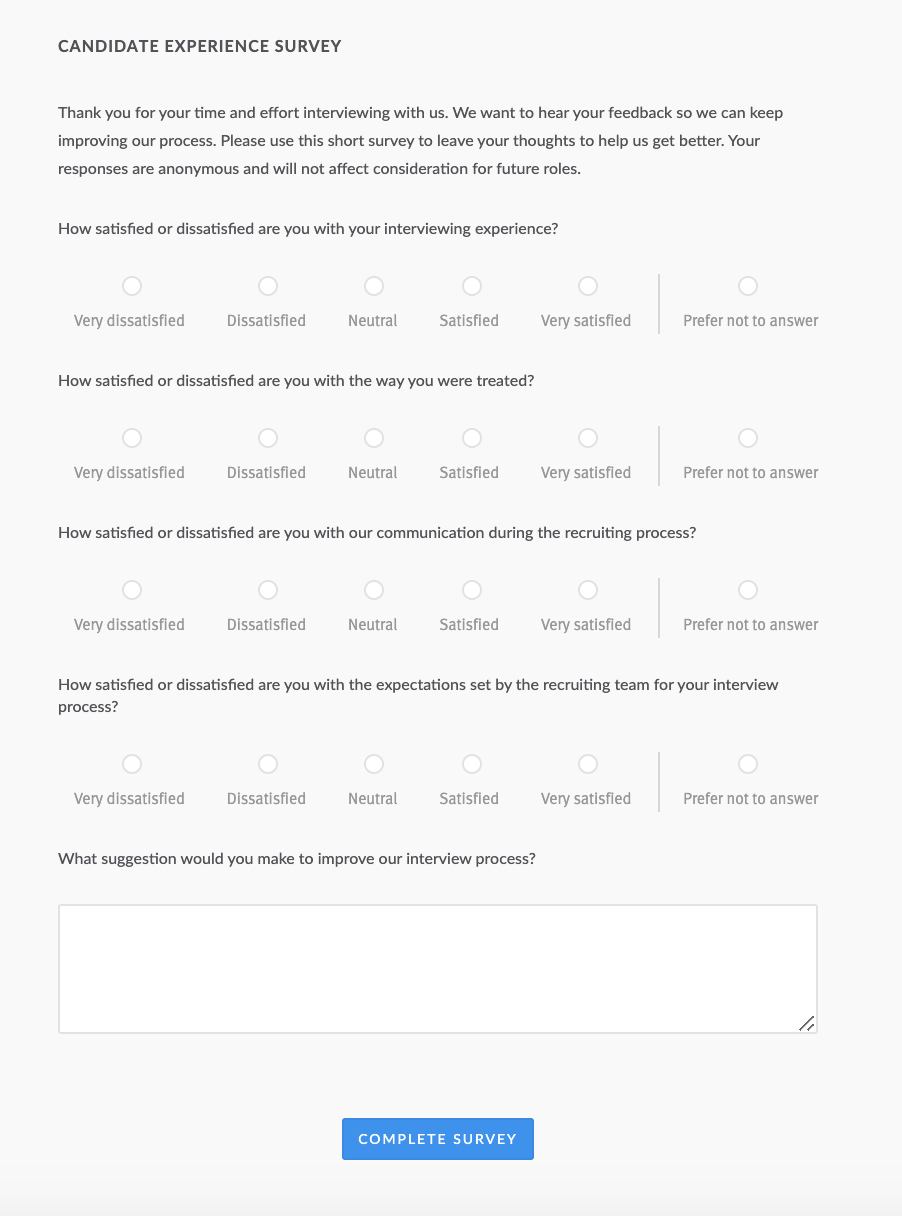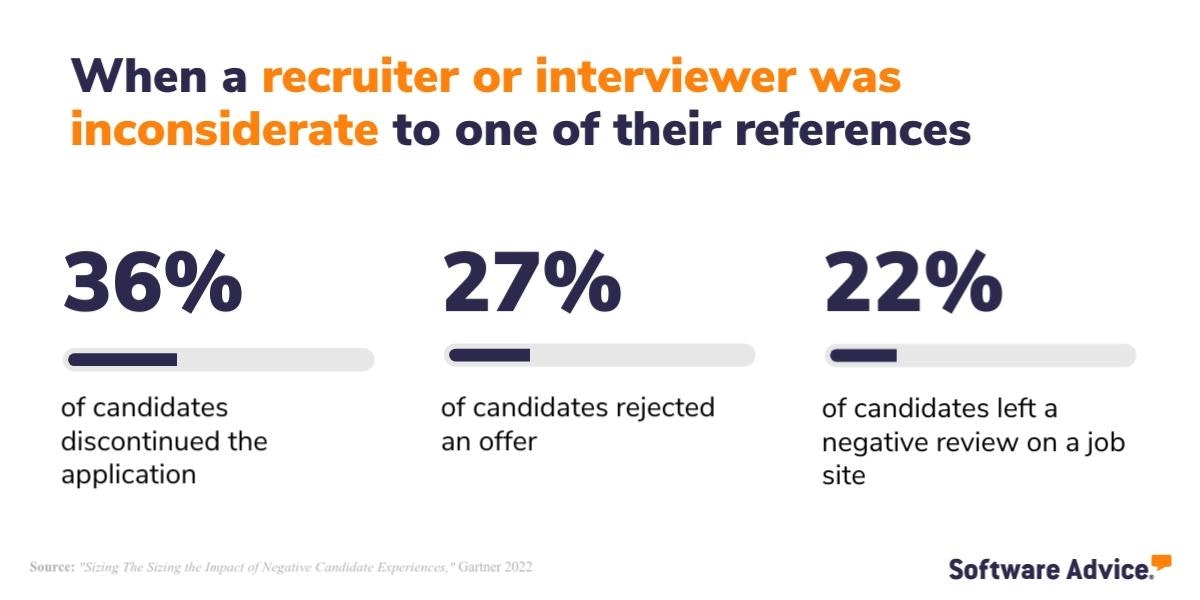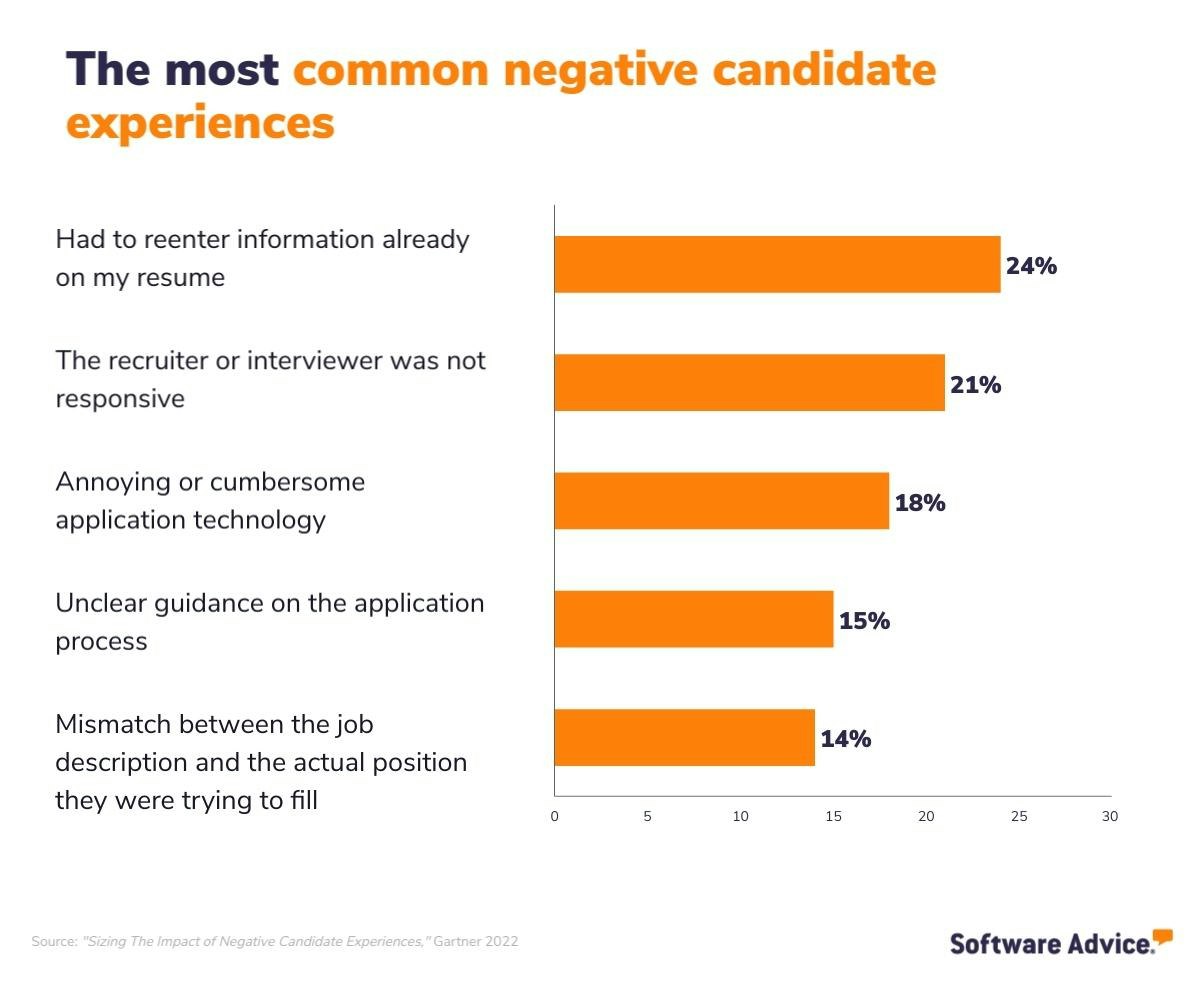Why You Should Add Candidate Experience Surveys to Your Onboarding Process and What To Include in Them
Whether due to a scheduling miscommunication, a biased interviewer, or a misleading job description, most of us have had at least one terrible candidate experience throughout the course of our professional lives.
In fact, Gartner research confirms this: When applying for a job, two-thirds of candidates report having at least one negative experience.[1]
As a hiring manager or recruiter who is looking to fill roles during a talent shortage[2], this should be a concern for you. A negative candidate experience can cause applicants to drop out of the interview process, reject your offer, or post a review of their unfavorable experience with your company on a public job site—all of which put a damper on your hiring process.
But if you don’t know exactly what’s going wrong with your candidate experience, you can’t make the improvements necessary to turn it into a positive one, which is why every growing organization needs to incorporate candidate experience surveys into their talent management strategy.
We’ll cover:
What is a candidate experience survey?
Candidate experience surveys are a tool used to solicit feedback from applicants in order to identify areas that need improvement within an organization’s recruiting process. Typically, these surveys are managed by the HR department and administered with the help of recruiting software or survey tools.

An example of a candidate experience survey administered through Lever (Source)
Why does candidate experience matter?
Research shows that your candidate experience has a direct influence on your organization’s offer acceptance rate and employer brand reputation. If a job seeker applies and interviews for a position with your organization and has a less-than-favorable experience, they’re not just going to pass up an opportunity to work for your employer, they’re also going to tell their peers about it.
In Gartner’s 2021 Candidate Experience Panel, over 700 individuals were surveyed in order to understand how they responded to different negative experiences they’ve encountered while pursuing a role.[1]
Of those surveyed, 10% reported that they had experienced an interviewer or recruiter being rude or inconsiderate to one of their sources, and within that group, 85% took action:

This is just one of many examples of negative experiences reported by candidates. In fact, it’s not even the most common negative experience that was reported by candidates:

Based on the graphic above, you might be thinking that the percentage of candidates who have had these experiences is relatively low. And while that is true, the consequences of them are high: On average, 64% of survey respondents who have had a negative experience take action, whether that entails dropping out of the application process, rejecting a job offer, or leaving a negative review on an employer site.
To put it simply: Even if only a small percentage of your applicant pool have a bad experience, there’s a high chance that those that do will respond in a way that will negatively impact your business.
What should you ask in a candidate experience survey?
We’ve covered the why behind candidate experience surveys. Next, we’ll detail the what, who, and when, starting with what kind of questions you should include in your survey.
There are three main areas of the candidate experience your survey should focus on collecting feedback on:
Recruiting tools and technology
The recruiting team (including the recruiter, hiring manager, and interviewers)
External service providers
We’ll expand on each of these sections below, as well as provide examples of questions you can include in your survey.
1. Recruiting tools and technology
According to Gartner’s research, 30% of candidates back out when the application process is more difficult than they feel is necessary.[1] This is notable considering that technology troubles (such as having to navigate a cumbersome portal or reenter information already on the applicant’s resume) are among the most common negative experiences reported by candidates. Because of this, collecting feedback on the navigability of your applicant tracking system and careers page is essential.
Example questions:
How much do you agree or disagree with the following statement: “I found the portal I used to upload my resume easy to use.”
Strongly agree
Agree
Neither agree nor disagree
Disagree
Strongly disagree
Rate our career website on a scale of 1 (difficult to find/lacking substance) to 10 (informative/engaging).
2. Recruiters and hiring managers
Gartner found that communication issues between applicants and recruiters are also within the top negative experiences reported by candidates; for example, 21% of candidates experience extended gaps in contact with their recruiter after submitting an application, preventing any opportunities for them to seek additional guidance.[1]
But there’s another reason why collecting feedback on your hiring team’s performance is valuable: Typically, measuring your recruiters’ performance comes down to quantitative metrics such as time-to-hire and offer acceptance rate. Candidate experience surveys offer a chance to collect more qualitative information, such as whether your hiring team members were kind, responsive, and helpful throughout the process.
Example questions:
How much do you agree or disagree with the following statement: “The recruiter very clearly described all the job requirements and details.”
Strongly agree
Agree
Neither agree nor disagree
Disagree
Strongly disagree
Which of the following best describes how you feel about the following statement: “My phone and email communication with the recruiter was prompt.”
Always
Most of the time
Sometimes
Rarely
Never
3. External service providers
Do you use any external service providers to complete parts of your hiring process (such as background checks)? If so, it’s a good idea to ask your new hires about their experience interacting with those third-party providers. They’ll know better than anyone where there are bottlenecks in the process, and they’ll also be able to speak to whether the point of contact who manages your account is respectful and efficient.
Example questions:
To what degree do you agree or disagree with the following statement: “Communications from [external service provider] were prompt and professional.”
Strongly agree
Agree
Neither agree nor disagree
Disagree
Strongly disagree
Rate your experience working with [external service provider] on a scale of 1 (painstakingly complicated) to 10 (effortless and smooth).
Who should you send a candidate experience survey to?
The short answer is candidates who receive and accept offers.
Applicants who turn down offers usually provide a reason for doing so to the recruiter overseeing their placement (which is its own form of feedback that should be recorded in your HR platform or applicant tracking system). Further, candidates who have been rejected or dropped out of the application process may have a skewed perception of your candidate experience that influences their feedback—plus, it’s unlikely they’ll want to take the time to complete the survey in the first place.
All this to say, the ideal audience for a candidate experience survey is those who have gone through every step of the recruiting process, including accepting an offer.
When should a candidate experience survey be sent out?
Candidate experience surveys should be sent out a week or two after a new hire’s start date, while the process is still fresh on their mind. For simplicity’s sake, add completing the survey as a to-do on your new hires’ onboarding checklist.
Further reading: 10 Step Guide to Employee Onboarding Best Practices
Capture valuable feedback through candidate experience surveys
Last year, Software Advice surveyed 300 employees with recruiting responsibilities through the Recruiting Strategy Survey[*] and found that 56% fear there are job openings they’ll never be able to fill. Between widespread levels of high turnover[3] and a shortage of qualified workers, today’s recruiters face a lot of challenges when it comes to filling roles.
For that reason, creating a positive candidate experience is a worthy endeavor—and it begins with identifying which aspects of your current recruiting process need to be improved upon. Candidate experience surveys offer an easy way to do just that by capturing valuable feedback from those who made it through your recruitment pipeline.
If you’re ready to incorporate this strategy into your onboarding process, our parting advice comes in the form of three best practices to keep in mind while designing your own candidate survey process:
Keep the results anonymous: The best way to ensure your employees give honest feedback is to anonymize their results.
Make the survey brief: A short set of focused questions is much better than a lengthy list of questions that seem like they’re all asking the same thing. As new hires often have a long list of to-dos to get through during their onboarding process, it’s best to keep tasks such as this one as painless to complete as possible.
Automate where possible: While you can manually create a survey, share it with new hires, and analyze the results on your own, there’s no need to. Many applicant tracking systems offer the ability to automatically administer and analyze results from candidate experience surveys. Talk with your software vendor to see if this is a feature available to you, or visit our applicant tracking system software directory to discover hundreds of tools that can help you upgrade your recruiting process.
Methodology
*The Software Advice Recruiting Strategy Survey was conducted in July 2021. We collected 300 responses from workers with recruiting responsibilities at U.S. employers. The goal of this survey was to learn how much companies are struggling with recruiting and hiring, and what solutions they’ve considered to improve recruiting and hiring outcomes.
Note: The applications mentioned in this article are examples to show a feature in context and are not intended as endorsements or recommendations. They have been obtained from sources believed to be reliable at the time of publication.
Sources